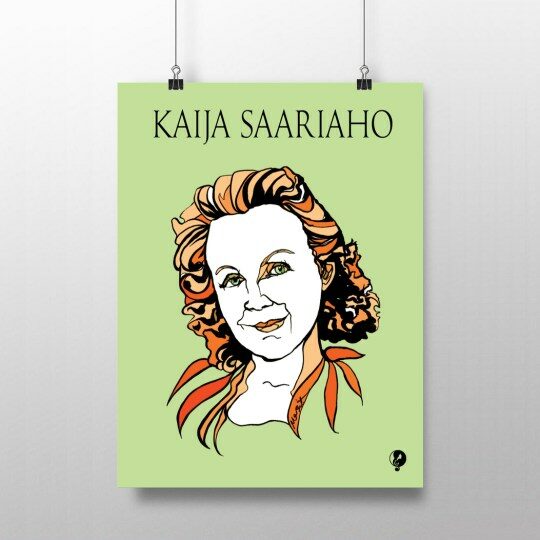
Composer Information
Birth - October 14, 1952 | Helsinki, Finland
Nationality - Finnish
Era - Modern
Composer Biography
Written by: Braeden Weyhrich
Finnish composer Kaija Saariaho showed talent in multiple art forms from a young age. She began studying visual art at the Fine Arts School of Helsinki but quit after a short time to focus on music. She started her musical studies with Paavo Heininen at the Sibelius Academy soon after. She joined together with fellow Academy students Esa-Pekka Salonen and Magnus Lindberg to create Korvat auki ry or the Open Ears Organization, which sought to promote the music of young Finnish composers. In her 20’s, Saariaho moved to Germany to continue her study of composition with Brian Ferneyhough at the Hochschule für Musik Freiberg.
In 1982, Saariaho moved to Paris to begin studying and researching at the Institute for Research and Coordination in Acoustics/Music (IRCAM). She developed several new techniques for writing computer-assisted music and for working with electronics. One such invention was a microphone that amplifies each cello string individually, which is used in her 1992 piece “Amers” for cello, chamber ensemble, and electronics. While at IRCAM, she also developed a unique system of creating harmonic structures and a form of notation to better indicate details of the widening array of tones and sounds used in her compositions. These techniques were inspired by her interest in French spectralist composers, who based their compositions on computer analyses of sound spectra.
Saariaho’s early music included many experiments with technology and was characterized by an emphasis on tone color. She achieved this with an absence of pulse and extremely slow harmonic changes–her 1982 piece “Vers le blanc” “is essentially static; over the course of 15 minutes, the work changes one three-voice harmony into another.” Later in the 1980s, Saariaho maintained her emphasis on tone color while adding more expression and rhythm. These pieces still lack a general sense of pulse, but the harmony moves more quickly than in previous works. Her pieces “Jardin secret II” for harpsichord and tape, “Io” for chamber ensemble, live electronics, and tape, and “Nymphea” for string quartet and electronics exemplify this period in her compositional journey.
Most recently, Saariaho has begun composing opera. Her newest work and fifth opera, “Innocence,” premiered at the Aix-en-Provence Festival in July 2021. It was commissioned by a consortium of major opera houses and will be touring New York, San Francisco, London, Finland, and the Netherlands. One of its defining points is Saariaho’s use of multiple languages–performers must be prepared to sing in German, French, English, Greek, Finnish, Spanish, and Czech, and in various styles within those languages like Sprechstimme and folk styles. Like her instrumental works, “Innocence” is thickly scored and changes harmony inconspicuously, creating a challenge for vocalists.
Saariaho has received several prestigious awards for her music, including the Grawemeyer Award, The Wihuri Prize, The Nemmers Prize, The Sonning Prize, and the Polar Music Prize. She continues to live in Paris, and is still accepting commissions and writing new music. An archive of her works is kept at the Paul Sacher Foundation in Basel, Switzerland.
See Also
- Barone, Joshua. “A Reigning Opera Composer Writes of Trauma and ‘Innocence.’” The New York Times (New York, NY). July 2, 2021. https://www.nytimes.com/2021/07/02/arts/music/innocence-opera-aix-festival.html.
- “Biography.” Kaija Saariaho. Accessed July 14, 2021. https://saariaho.org/biography/.
- “Kaija Saariaho: Laureate of the Polar Music Prize 2013.” Polar Music Prize. Accessed July 19, 2021. https://www.polarmusicprize.org/laureates/kaija-saariaho/.
- Korhonen, Kimmo, and Risto Nieminen. “Saariaho, Kaija (Anneli).” Grove Music Online. January 31, 2002. https://doi.org/10.1093/gmo/9781561592630.article.45895.
All Poster Lines
Check Out All Our Poster Lines

